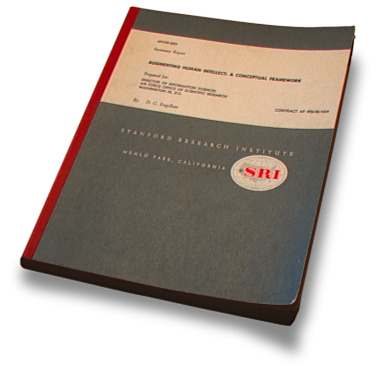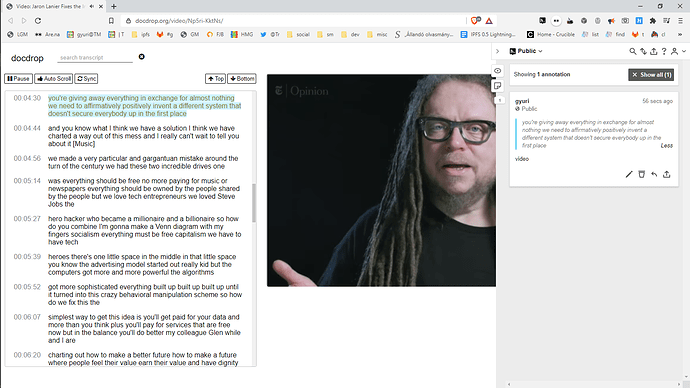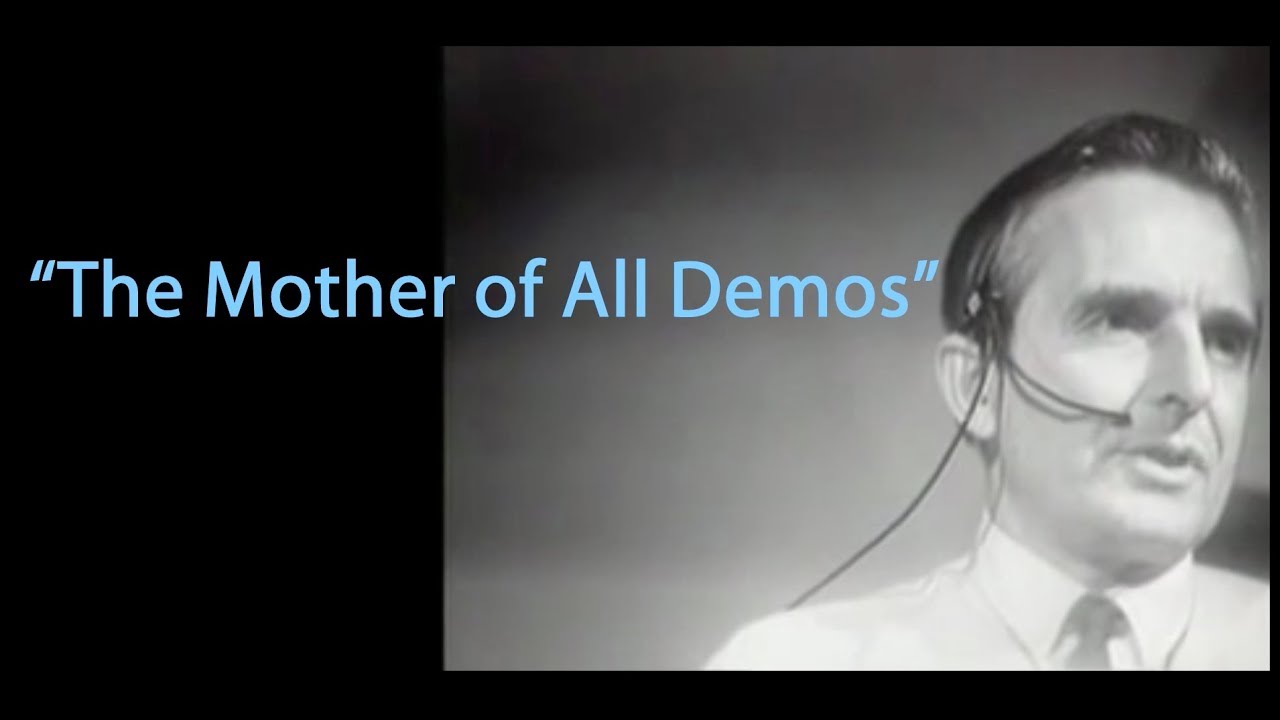This may be some permission in the forum configuration.
That’s a bummer. will look into it.
I have just come across this tweet. https://twitter.com/dwhly/status/1304432076825878528
Tried video annotation, amazing
Install the hypothessis chrome extension from
signup here: https://web.hypothes.is/
[https://docdrop.org/video/Np5ri-KktNs/](http://link to annotated talk)
Very nice. Thanks for sharing.
my inspiration to act or to work (to dream, to sense-make, to design and create) happens both kinesthetically and within trusted groups, neither of which conditons apply here (yes this a group but not yet trusted because i’ve never met any of you here except for jerry which was about 20 years ago)…
I see
Trust as a transitive relation with strength diminishing with distance.
I had the privilege of meeting Jerry first time only this year. Thanks to CICOLAB’s efforts for proactively seeking out and connecting people who care about “Collective Intelligence”
Took the trouble of finding out about his work 7 years ago. He gained my deepest trust there and then, and shared his vision all along. Trusting that we shall connect one day.
So first order connections carry a high degree of trust for me. Discover through trust but verify.
If we are the system, what is our goal?
there are think tanks being funded by rich people whose total job it is to secure the financial advantage of their employers. Think of the Heritage foundation, ALEC and so on. These folks make very good money and enjoy a pretty good life.
Then there are funders who have altruistic reasons, or simply feel existential angst and want to intervene where possible. Who are they going to for best in class insights? Not to figure out how the boss can screw the tax system, or what voters should think about who to vote for.
But instead bring together talent that can solve complex problems on a macro level, like the farm bill, like education reform, money reform. That should be a good reason to earn a living, one would think. Why couldn’t we be a think tank?
just picked this one up in the thread and maybe this is the place to go with it.
Just to clarify briefly what I meant here:
Some people believe we can only solve our society/political problems
with new information (meta) technologies. Some think we should focus
on more concrete actions instead. Both positions are fine. We just
have to acknowledge different beliefs and organize accordingly. Else
the different camps are just creating “noise” for each other. So let’s
have focused discussions on the forum! 
Can we think about this some more. How would we work on designing a system, or even understanding a system, without connecting both meta and concrete actions? Can we design systemic changes and then what??? drop them from a plane?
Theory is great, that’s what we do. But without a prototype model that is structured to provide real life feedback from a complex adaptive moving as we speak system, what good is it? There has to be level 1 narrative which then translates into every more operational detail, using the Donella Meadows model.
There is a tried and tested approach, Envisioned nearly 58 years ago:
http://www.1962paper.org/web.html

“systematic approach to improving the intellectual effectiveness of the individual human being.”
demonstrated to work in 1968
due perhaps to a "systematic bias against the improvement of what [Doug engelbart] call “Collective IQ.”
the full potential of the demonstrated bootstrapping approach has never got wide traction.
.
This may well be because the idea of self-hosting, metacircularity and kernel based extensibility, let alone co-evolving in teams, is just too hard.
Alan Kay’s Smalltalk had all these characteristics baked into the language/sytem/tools that nobody seem to have ever used. Emacs had these characteristics, always had a dedicated following. Some of these ideas are being baked into VSCode, but we need to make it all accessible to all, requiring no more then the ability to compose an email message perhaps.
What is needed to “connect meta and concrete action” is a minimal viable extensible collaborative kernel that can empower collaborative action in self organizing network of networks, here and now, where we are, but doing it such a way that the very means used in that work can be made explicit, shared and co-evolvable as we are building it as we fly.
Oh, and we need to be able to Show rather than Tell, first.
no need to repeat the urgency of the moment, we have discussed that at great length. This week was the Sustainability Innovations Forum hosted by the UN, consensus opinion is we are flat out of time to secure the climate. The last day was focused on food and agriculture, I liked this short talk by Prince Charles who has long been an activist.
There is general consensus in academia and amongst industry experts that such behavior driven massive changes in the economy have to start at community level, have to be built ground on up. Another webinar this week focused on the concentration in the food system that has to be broken up to enable local control over the ecosystem.
The challenge is to work from the ground on up while at the same time pointing the system into a common direction. There are many examples of successful community developments, here are a few just published, but there is no coordinating structure that would connect such case studies, review them for repeatability and scalability, and then make them available in an easy to find structure.
To connect meta level thinking to concrete action in Theory U language would bring us the the prototyping phase.
Prototyping Interview with Otto Scharmer
Does that make any sense?
It depends. Sometimes I sit, like when I have to type things in (I hate writing things down because it’s too slow and my handwriting is too messy), but I also find that pacing can aid me in thinking. Sometimes my thoughts flow so quickly that I wish I had a device that could copy them from my head, but I think that’s a few years away yet, so a voice-based input system that’s very reliable that would allow me to record things as they passed in (and out) of my head. Eventually, it would be nice to have an AI that would help sort through it, organizing, correlating, and so on. Sometimes I think in words, other times I visualize, or use other imaginary sensing to see how I’ll react. I think there are other times when it happens in the level below words and pictures, but I don’t think that’s something I have full control over - it’s like the machine language and assembler running in the background doing the grunt work. I am also aware that there are some people who ONLY think using pictures and, thus, find language to be more challenging.
So, basically, a portable voice-input system with advanced features since I don’t think technology has advanced enough to handle the rest. For those of us who use pictures at least part of the time, perhaps the Unicode characters plus some other stuff might be a good idea, especially if it allows pictorial representation and recording.
I hope that helps.
Right. But how do we proceed to do DSRP. Hint It is NOT just by creating Causal Loop Diagrams.
About CLD Cabrera said:
" The big weaknesses of System Dyamics (CLDs)models are: (1) no perspectives or explication of perspectives; (2) no zooming into the relationships (RDSs); (3) no nested part-whole structure; and (4) no identity-other accounting in their Distinction making. Otherwise, SD is a very powerful method. "
I add that SD models do not consider goals
How does one actually DO DSRP. (Hint: Only in activity modeling do we DO DSRP)
aside:
I’m a fan of thinking systems, from I Ching to Leibniz’s characteristica universalis to Peirce and Sowa’s graphs to DeBono’s po and lateral thinking to William S. Burroughs’ “Destroy all dogmatic verbal systems.”
Lots of Fourfold Analysis models out there. Didn’t know about DSRP – which is kinda 8-fold.
These helped:
DSRP is solely implemented by Data Flow Diagrams
Hi Tony, do you have a link to a DSRP DFD? Are you sketching some for OGM parts? Love to see an example. No rush.
Should I consider these an example? Activity (and other) Diagrams of OGM
MC:
DSRP is how we think systems wise. A Data Flow Diagram is an artifact. It is the result of thinking in terms of DSRP.
The diagram you refer to does not show flow.
But you do recognize the arrows, don’t you? What do they indicate, if not data flow? True, I’m not using a particular formal/common data flow diagramming notation, are not trying to model some activities or represent system models, just data flows.
Hi:
I should have been more precise. The diagrams do not show flow of inputs and outputs. Except at the very detail level, Activity diagrams need to show input/outputflows because inputs/outputs define the activities.
Data flows need to be labeled to show what data is flowing.
Perfect, that’s great and constructive feedback! I/we might look into adding such details, if some live/“weekly”/current/up-to-date data flow diagramming overview should be continued.
Saliam
How do you think? I think systematically, as per Systems Thinking
And when you are at your best, what do you wish was there to help you? This one is EASY, always, always it is the same thing: Information to enable me to understand the “As Is” activities being accomplished.
Tony Markatos


